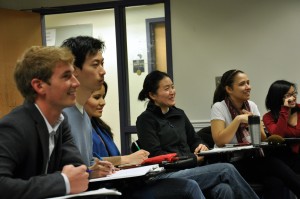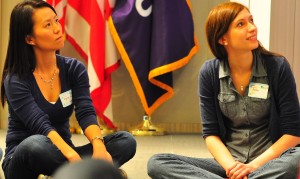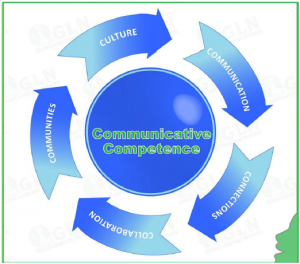Our Unique Model
GLN makes language learning accessible and affordable for all.
The GLN model has five pillars:
 Our Teachers: we engage, recruit and train highly capable and motivated native speakers who volunteer their time to teach their language and share their culture with our community. Read more about our Teaching Fellowship
Our Teachers: we engage, recruit and train highly capable and motivated native speakers who volunteer their time to teach their language and share their culture with our community. Read more about our Teaching Fellowship
Our Organizational Volunteers: we engage talented individuals from our community who volunteer their time to support our operations – from program development to marketing and fundraising. See our people.
Our Communicative Approach: we create a comfortable environment where learners and teachers collaborate as learning partners. We develop learners’ communicative competence by facilitating communicative contexts in the classroom. Read more about our approach in subsequent tabs
Our Pricing Model: we use an innovative pricing model: for a 6-12 week semester of language learning (12-24 hours of in-class instruction), our students pay a small one-time fee of $200. Half that amount is refundable if learners have good attendance (miss no more than two out of the twelve classes, or one out of eleven or less classes). That means a 24-hour semester-long GLN language class can cost as little as $100.
Our Partners: GLN classes meet in various locations in the Washington, DC-metro area. We collaborate with organizations who espouse diversity and multiculturalism and support our mission by hosting our classes. Read more about our partner network.
The GLN Educational Philosophy
The reasons for studying a foreign language are diverse, depending on each learner’s needs and goals. Whether our students are looking for career enhancement or personal enrichment, GLN works to provide a rewarding learning experience for all. We believe that competence in more than one language and culture connects and empowers people.
We have adapted our language learning model, The Six C’s of GLN
from ACTFL’s Five C’s of Foreign Language Education. We have placed a sixth C, Communicative Competence, in the center of our model, since this is the ultimate goal of our program and our learners.
- Culture: By studying other languages, we gain a knowledge and understanding of the cultures that use that language and, in fact, cannot truly master the language until we have also mastered the cultural contexts in which the language occurs.
- Communication: Communication, whether face-to-face, in writing, or through reading, depends upon how a person uses language, culture, and experience to send, receive, and interpret messages.
- Connections: Language is a tool that can establish connections to additional knowledge and networks and build relationships with people that may be unavailable to the monolingual speaker.
- Collaboration: Through sharing and collaboration, learners, teachers, volunteers, and staff build relationships that foster passion and commitment to lifelong language learning.
- Communities: Insight and direct experience with a target language and culture enable individuals to participate in, and transform, multilingual communities at home and around the globe in a variety of contexts and in culturally appropriate ways.
- Communicative Competence: Communicative Competence requires the ability to effectively use linguistic and social knowledge to communicate in meaningful and appropriate ways with users of other languages.
The GLN Approach
There is no perfect language learning model for all contexts. At GLN, we have examined a variety of sources, including our own collective experience, and have constructed a communicative approach that responds to the needs and interests of our learners. We do not speak of using the communicative approach, but rather a communicative approach, a distinction that we find respectful of the diverse thinking in the field.
 We base our communicative approach around a handful of basic principles.
We base our communicative approach around a handful of basic principles.
- We begin with meaning. Keeping in mind the needs and interests of our adult learners, we have designed courses, units, and activities to engage learners in meaningful communication within topics of interest and use to them.
- We also attend to form. Within or subsequent to meaning-focused activities, we highlight and teach relevant structures and vocabulary. Fluency and accuracy become two sides of the same coin in our classes, although fluency takes priority as students are engaged in meaningful language use.
- We provide a fully immersive experience in the target language. We challenge our teachers to use the target language as much as possible, even in beginning classes. This provides maximum exposure to the language, which helps increase learning rates and outcomes.
- We provide generous opportunities for output. For centuries, it has been observed that one of the best ways to learn a language is by using it. Thus, we provide many opportunities for students to use the language to communicate for authentic purposes.
- In GLN classrooms, students use the target language meaningfully, both receptively and productively, in unrehearsed and culturally appropriate contexts, thus arriving at communicative competence.
In GLN communicative language classes, the teacher’s role includes introducing vocabulary and phrases and providing comprehensible language input for the students. Our teachers find themselves talking less and listening more, becoming active facilitators of their students’ learning. The students do most of the speaking and because of the increased responsibility to participate, students find they gain confidence in using the target language in general.
GLN’s impact can be measured in the number of people we have served, the vast number of languages we promote and in the professional development opportunities we provide to our dedicated volunteers.
Here’s a snippet of what we’ve accomplished:
- 62 Languages
- 600+ Teacher Volunteers
- 250+ Organizational Volunteers
- 9,000 Learners Served
- 5,000+ Hours of Volunteer Hours
- 1,600+ Individual Donors
- 28 Community Partnerships
And here’s what GLN language learners are saying about us in their end-of-semester evaluations:
- 98% of our learners see a significant impact on their overall language competence after completing a class with GLN
- 92% of our learners are significantly more interested in the language and culture after completing a class with GLN
- 99% of our learners would recommend GLN to a friend

